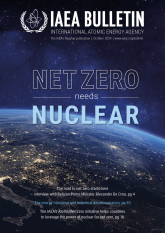
If you would like to learn more about the IAEA’s work, sign up for our weekly updates containing our most important news, multimedia and more.
Large Reactors Poised to Lead the Nuclear Power Expansion as Small Modular Reactors Advance
Joanne Liou
Scaling up nuclear power to the level needed to achieve net zero is a significant and multifaceted undertaking, and while many reactor types may play a role, large reactors are set to lead the way. Large water cooled reactors were central to the rise of the nuclear industry in the 20th century, and the advanced reactors planned or under construction today, many of which are in the 1–1.7 gigawatts (electrical) (GW(e)) range, are poised to provide the bulk of new nuclear capacity.
“For countries already operating nuclear power plants, large light water reactors, rather than small modular reactors (SMRs), will drive the increase in nuclear capacity,” says Aline des Cloizeaux, Director of the IAEA’s Division of Nuclear Power. “Large reactors are a proven technology that can economically provide a large and reliable baseload of energy. But we do expect countries and industries to tap into the potential of SMRs as well.”
Nuclear power must be expanded to meet the world’s net zero goals — that was the clarion call issued by IAEA Director General Rafael Mariano Grossi last December at the 28th session of the Conference of the Parties to the United Nations Framework Convention on Climate Change (COP28), in a statement supported by dozens of countries. This position was affirmed by the inclusion of nuclear power in the Global Stocktake for the first time in the Conference’s almost 30-year history.
In a high case scenario, the IAEA’s projection is that nuclear energy capacity will more than double by 2050, from 371 GW(e) in 2022 to 890 GW(e) by 2050, with only around 10% of this increase expected to come from SMR deployments. Hitting this mark means adding at least 20 GW(e) per year. “The high case projection is ambitious but technically feasible,” says Henri Paillere, Head of the IAEA’s Planning and Economic Studies Section.
Smaller reactors like SMRs and microreactors may be particularly suitable for providing power to industrial end users and remote communities with smaller electric grids, and for powering non-electric applications such as hydrogen production and seawater desalination. However, SMRs will need demonstration before their broader deployment; larger reactors will continue to dominate the nuclear power landscape in the years to come.
Almost all of the 58 nuclear reactors currently under construction are large reactors, and expansion plans in nuclear power operating countries and newcomer countries alike are mostly centred around reactors with 1 GW or more of capacity, although many of these countries are eyeing eventual SMR deployment as well. Poland, a newcomer aiming to add nuclear by the mid-2030s, plans to deploy 6–9 GW(e) of generating capacity with large nuclear power reactors. China, which currently operates 55 reactors, expects to expand its nuclear power capacity eightfold to around 400 GW by 2060, mainly through the deployment of large reactors.
Challenges to nuclear expansion
According to Paillere, the biggest challenges in expanding nuclear energy capacity are those related to financial and human resources: “Mechanisms are needed to attract capital from investors and the private sector to fund new nuclear projects. There is enough money to fund investments for the clean energy transition. What is making investors cautious of nuclear power is the risk, like delays in construction”.
After a hiatus of decades in nuclear new builds, the construction of large, first-of-a-kind nuclear projects in Western countries has often been plagued by cost overruns and delays, as skills are relearned and processes revitalized. “There had not been construction in 20 years in some of those countries. Human resources needed to be trained and supply chains rebuilt,” says Paillere. “Increasing nuclear capacity means increasing construction and grid connections, which means finding more engineers, technicians, welders and more. The issue of human resources is not specific to nuclear, but it is a common challenge across clean energy technologies”. Lessons learned from previous projects, including in project management and stakeholder engagement, will be critical to the timely completion of new build endeavours.
In some countries, such as Belarus, China, the Republic of Korea, the Russian Federation and the United Arab Emirates, new build projects — most of which entail the construction of advanced water cooled reactors — have proceeded largely on time and on budget. “The standardized design of advanced reactors expedites licensing and reduces both capital costs and construction time,” says des Cloizeaux.
Past and future expansion
The 1970s saw a boom in nuclear power expansion, driven mainly by North America and Europe. In 1970, 15 countries operated 90 nuclear power reactors with a total capacity of 16.5 GW(e). Throughout the 1970s, construction started on 25–30 new nuclear units annually. By 1980, 22 countries operated 253 nuclear power reactors with 135 GW(e) of capacity. By the end of 1990, nuclear capacity had more than doubled to 326 GW(e) worldwide.
“The nuclear industry and supply chain were well established and able to build 30 GW per year,” Paillere says. “This is encouraging because, at that time, there were only a few countries leading the trend, such as France, Japan and the United States of America. Today, China and the Russian Federation have become major players and have the supply chain and industry to support the expansion of nuclear power”.
A revival and expansion of nuclear power to achieve global goals, whether through large reactors or SMRs, will require policy support and tight cost controls. “The momentum to realize the goals is there, but it will take more political action,” says des Cloizeaux.






